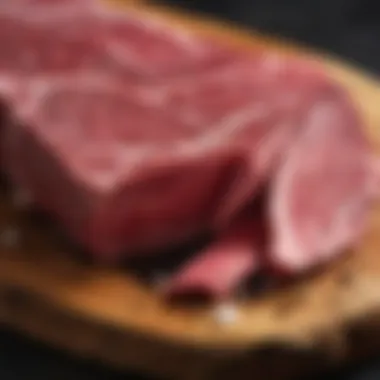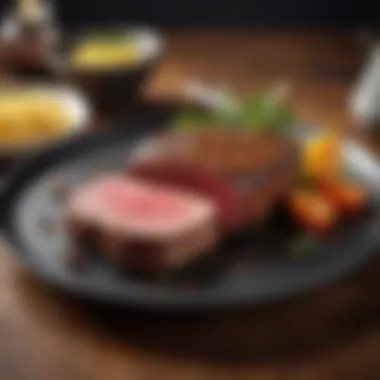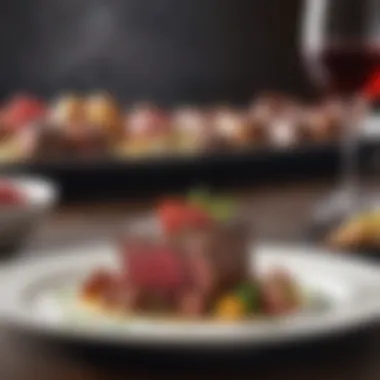Understanding the Cost of Kobe Beef: Factors and Insights


Intro
The cost of Kobe beef is a topic that intrigues chefs, gourmets, and food enthusiasts alike. Unique in its flavor and texture, Kobe beef commands high prices, often raising curiosity about the reasons behind its valuation. It is important to understand various factors that contribute to this cost, including quality, regional variations, and market dynamics. By exploring these aspects, readers will gain valuable insights into what sets Kobe beef apart from other premium varieties.
Kobe beef originates from the Tajima strain of Japanese Black cattle, raised in the Hyogo Prefecture of Japan. Its marbling, tenderness, and flavor profile make it one of the most desirable meats in the world. This article delves into several key components that shape its pricing, including the breed's unique characteristics, production methods, and market trends surrounding luxury meats. Uber aficionados and culinary professionals are given tools to navigate the Kobe beef market effectively.
The Basics of Kobe Beef
Understanding Kobe beef requires a foundational awareness of its unique characteristics and origins. This knowledge not only enhances appreciation for this luxury ingredient but also informs purchasing decisions and culinary applications. The basics of Kobe beef primarily encompass its definition, origin, and distinct qualities that set it apart from other beef types.
Definition and Origin
Kobe beef originates from the Tajima strain of Japanese Black cattle, which is raised in Hyogo Prefecture, Japan. This breed holds a significant cultural history and has been nurtured for centuries. The term "Kobe beef" is often misused globally, but to be authentic, the meat must come specifically from this region and adhere to strict guidelines regarding breeding and processing.
To qualify as Kobe beef, the meat must come from cattle that have been raised according to meticulous standards concerning diet, environment, and overall care. The history of Kobe beef can be traced back to the Meiji era when Western-style ranching methods were introduced in Japan. Thus, Kobe beef is not just a product; it is a representation of a unique and refined culinary heritage.
Characteristics and Quality
Kobe beef is famously known for its superior marbling, tenderness, and rich flavor. The fat content in Kobe beef creates a tender texture that dissolves in the mouth. This marbling is a result of specific breeding and feeding practices, leading to a high degree of intramuscular fat. When cooked, the fat melts, providing a unique flavor profile that is both buttery and savory.
The quality of Kobe beef is graded on a scale that assesses its marbling, color, firmness, and texture. The highest grades are sought after and command premium prices. Naturally, this high quality comes with an elevated cost, influenced by production constraints, breeding methods, and market demand.
"Kobe beef epitomizes luxury in the culinary world, offering a unique experience that transcends typical beef steaks."
In sum, an understanding of the basics of Kobe beef sets the stage for exploring the deeper factors influencing its cost and value. This knowledge lays the groundwork for appreciating both its culinary applications and the broader implications in the luxury meat market.
Factors Affecting the Price of Kobe Beef
Understanding the price of Kobe beef involves examining several interrelated factors. These factors not only illuminate why this specific meat commands a high price but also offer insights into its culinary value. For culinary professionals and food enthusiasts alike, recognizing these attributes is essential to informed decision-making regarding its use in various dishes. The high cost is not arbitrary; it reflects the entire process of production, from breeding to marketing, and encompasses the limited availability of genuine Kobe beef.
Rarity and Production Limits
Kobe beef is not widely available. Its rarity is one of the primary factors influencing its price. Only cattle that are born and raised in the Hyogo Prefecture of Japan can be labeled as Kobe beef. This geographic limitation creates a significant production cap. In addition to the strict geographical requirements, the total number of cattle certified as Kobe beef remains low. The Kobe Beef Marketing & Distribution Promotion Association actively regulates and certifies this beef to ensure quality, resulting in a limited supply that directly correlates with higher prices.
The exclusivity also arises from the specific breed of cattle used for production. The Tajima breed contributes distinct texture and flavor to the meat, reinforcing its high demand in the luxury market. For consumers seeking an authentic experience, this rarity translates to a willingness to pay premium prices.
Breeding and Feeding Practices
The breeding and feeding practices for Kobe calves significantly affect the final product's quality and, consequently, its price. Farmers prioritize specific genetics to yield beef with exceptional marbling, tenderness, and flavor. Each animal is raised under stringent conditions, with a focus on individual care rather than mass production.
Feeding plays a crucial role as well. Kobe cattle are often fed a specialized diet, which can include high-quality grains and grasses. Some growers claim to use beer or sake mash to stimulate the cattle's appetite. This unique feeding regimen results in the distinct intramuscular fat that is characteristic of Kobe beef, creating a rich flavor and a buttery texture.
Furthermore, the cattle are often raised in stress-free environments. The absence of stress during the rearing stage is essential because stress negatively impacts meat quality. This meticulous attention to breeding and feeding leads to higher production costs, which are then reflected in retail prices.
Aging Processes


The aging process of Kobe beef is also a significant factor in its price determination. Aging, particularly dry aging, allows the beef to develop deeper flavors and a more tender texture. This process requires skill and precision to avoid spoilage while enhancing flavor.
Kobe beef is usually aged for a specific duration to maximize its quality. This not only involves time but also controlled conditions, including temperature and humidity. The aging process adds a layer of labor and resource investment, further elevating its market price.
The combination of rarity, meticulous breeding and feeding practices, along with sophisticated aging processes, culminates in a product that is not just meat but an experience.
Price Comparisons
Understanding pricing comparisons is essential when exploring Kobe beef. It allows consumers to discern the unique value proposition of Kobe versus its counterparts. By analyzing these comparisons, one can appreciate the specific qualities that drive Kobe beef's premium cost. Additionally, this section offers insights that can help buyers make well-informed decisions, optimizing their culinary experiences.
Kobe Beef vs. Wagyu
Kobe beef is often discussed alongside Wagyu, but several distinctions exist between the two. While all Kobe beef is considered Wagyu, not all Wagyu qualifies as Kobe beef. Kobe beef comes specifically from the Tajima strain of Japanese Black cattle raised in the Hyogo Prefecture. This limited geographic scope contributes to its rarity and elevated price.
On the other hand, Wagyu refers to several breeds of cattle raised throughout Japan. They share certain characteristics, like high marbling and tenderness. However, the pricing for Wagyu beef can vary significantly, depending on factors such as the breed, gender, and region of production.
Here are some factors affecting pricing differences between Kobe beef and Wagyu:
- Authenticity: Kobe beef's strict regulatory measures ensure authenticity, demanding higher prices.
- Production Methods: Kobe beef undergoes specific breeding and feeding processes that enhance its quality, contributing to its cost.
- Consumer Demand: Kobe's rarity elevates its standing in the luxury market, increasing its price compared to other Wagyu varieties.
Kobe Beef vs. Other Premium Beef Cuts
When compared to other premium beef cuts, Kobe beef often emerges as the top choice for consumers seeking an exceptional culinary experience. Cuts like Filet Mignon or Ribeye may offer great flavors and textures, but Kobe beef distinguishes itself through its unparalleled marbling and tenderness.
Several aspects influence the pricing of Kobe beef versus other premium cuts:
- Marbling: Kobe beef typically has a higher intramuscular fat content, resulting in a more succulent and flavorful eating experience.
- Aging: The aging process applied to Kobe beef often exceeds that of other cuts, allowing for a richer flavor development, which justifies its higher price.
- Availability: Unlike more widely available cuts, Kobe beef's limited supply drives demand and subsequently, its price.
Market Trends in Luxury Meats
The luxury meat market, which includes Kobe beef, has undergone substantial changes in recent years. Economic factors, consumer preferences, and sustainability considerations play crucial roles in shaping this market.
Observing current market trends may provide deeper insights into pricing fluctuations and buyer behavior:
- Sustainable Practices: With increasing consumer awareness about sustainable farming, premium cuts that prioritize ethical production can see rising demand.
- Globalization: The international reach of culinary trends brings about an increased appreciation for high-quality meats, influencing prices globally.
- Gourmet Dining Trends: There is a growing enthusiasm for gourmet dining, which elevates the stature of luxury meats such as Kobe beef, affecting associations between quality and pricing.
In summary, when assessing price comparisons, one must consider how Kobe beef stands in relation to other types of Wagyu and premium beef cuts. Additionally, awareness of market trends can guide consumers as they navigate the complex landscape of luxury meats.
Regional Price Variations
Understanding regional price variations is essential when exploring the cost of Kobe beef. Prices can fluctuate significantly based on geographic location. This variation adds layers of understanding to the pricing structure and helps consumers navigate choices effectively. The benefits of knowing these variations include gaining insight into local pricing strategies, understanding supply chain factors, and recognizing the influence of regional culinary markets.
Pricing in Japan
In Japan, Kobe beef is more than just a culinary delight; it is a cultural symbol. The price of Kobe beef in its place of origin reflects the exquisite quality of the meat. Factors such as local demand, production regulations, and limited supply greatly influence pricing. Typical prices for premium cuts might range from 10,000 to 30,000 yen per kilogram. This high cost can be attributed to the stringent grading system, where only a select few cattle receive the Kobe designation.


In addition to the luxury image, the process of raising the cattle is also significant. Farmers dedicate their lives to ensuring the cattle are taken care of according to established standards. As a result, prices in Japan can be higher than in other parts of the world due to labor costs and traditional farming methods.
Moreover, availability may influence prices. During festivals or holiday seasons, demand swells, often resulting in higher prices. This highlights the need for consideration when planning events or purchases.
Kobe Beef Pricing in the United States
The United States presents a different landscape for Kobe beef pricing. American markets often label various beef products as "Kobe" or "Wagyu," which can create confusion. Authentic Kobe beef, raised and certified in Japan, usually comes at a steep cost, often beginning around $200 per pound.
In the US, prices are subject to import fees and distribution costs. The presence of misconceptions about Kobe beef can mislead consumers about its true worth. Additionally, the market is influenced by trends, where price can vary according to popularity and demand.
Here are some factors affecting prices in the United States:
- Location: Urban areas like New York or Los Angeles may see higher prices due to demand.
- Source: Authentic Kobe beef commands higher prices than hybrid Wagyu breeds.
- Supplier: Different suppliers implement various pricing strategies based on cut and availability.
Understanding these factors will guide consumers in making informed purchasing decisions.
Buying Kobe Beef
Buying Kobe beef requires a careful approach, driven by several crucial factors. The unique characteristics of this meat mean that it cannot be treated like regular beef purchases. Understanding what to look for can help you make informed decisions that enhance your culinary experiences.
First, it’s important to choose the right source. Not all vendors sell authentic Kobe beef. Look for reputable suppliers who provide clear information about the origin and quality of their products. The cost is typically higher than for standard beef, but the experience can be worth it. Knowing where to look can save time and ensure satisfaction.
Where to Purchase
The primary places to buy Kobe beef include specialty butcher shops, high-end grocery stores, or reputable online retailers.
- Specialty Butchers: These shops often have trained staff who understand the specifics of Kobe beef. They can provide guidance on cuts and cooking methods.
- High-End Grocery Stores: Stores like Whole Foods may carry quality beef but confirm the authenticity before purchasing.
- Online Retailers: Websites such as Crowd Cow or Snake River Farms sell Kobe beef, often with detailed descriptions about sourcing and meat quality.
When buying online, look for reviews or ratings to gauge reliability.
Authenticity and Certification
Authenticity is paramount when it comes to Kobe beef. Not all wagyu beef is created equal, and many retailers use the term loosely. To ensure you are buying genuine Kobe beef, check for certification.
- Japanese Government Certifications: Look for certifications from the Japanese government, confirming that the beef comes from the Hyogo prefecture, specifically from Tajima cattle.
- Quality Grade: Kobe beef is graded based on marbling, color, and overall quality. The best quality is A5, indicating superior fat distribution.
"Kobe beef’s allure lies not just in its flavor, but also in the prestige that comes from knowing you have an authentic product."
Before purchasing, ask the retailer for proof of certification. This can include grading reports or documents detailing the meat's origins. This step cannot be overlooked, as it ensures that you receive not just the best quality but also the true essence of Kobe beef.
Understanding Price Fluctuations
Understanding price fluctuations in Kobe beef is critical for anyone involved in culinary arts or gourmet dining. The cost of this luxury meat does not remain constant. It can vary significantly based on multiple factors. Knowing these can help buyers make informed choices. Here, we explore two major influences behind the fluctuating prices: economic factors and global demand-supply dynamics.
Economic Factors


Economic conditions play a substantial role in the pricing of Kobe beef. Changes in the economy influence consumers' disposable incomes. When the economy is strong, more people are willing to buy high-end products, including Kobe beef. This increased demand can lead to higher prices. Conversely, during economic downturns, consumers tend to cut back on luxury purchases, affecting demand and price.
Several specific economic indicators also impact prices:
- Inflation can increase the costs of production, such as feed and labor.
- Currency exchange rates matter, especially when looking at imported Kobe beef. A weakening currency can raise prices.
- Trade policies can impact import/export costs, adding to the total price for consumers.
Buyers need to be alert to these economic trends. They directly affect the retail price of Kobe beef, influencing choices for restaurants and home cooks.
Global Demand and Supply Dynamics
Global demand-supply dynamics further complicate the pricing structure of Kobe beef. Kobe beef, recognized for its high quality, is desired across the world. As more consumers become aware of its characteristics, demand continues to grow.
This increased demand can lead to supply constraints, especially given that Kobe beef has a very specific and limited production. Some important points to consider:
- Population Growth: As more people in different regions desire Kobe beef, the limited supply leads to higher prices.
- Culinary Trends: As trends develop in gourmet dining, certain beef cuts may become more fashionable, increasing demand greatly.
- Seasonal Availability: Seasonality can affect production rates. Factors like climate and breeding cycles directly impact how much Kobe beef is available at any given time.
Culinary Applications of Kobe Beef
Kobe beef is not merely a meal; it is an experience that embodies both culinary artistry and high gastronomic value. As a result, understanding the culinary applications of Kobe beef is essential for anyone looking to elevate their dining experience or culinary skills. The unique qualities of Kobe beef—its marbling, flavor, and tenderness—allow it to be used in various preparations, each showcasing its attributes. Chefs and home cooks alike benefit greatly from knowing the best ways to prepare and serve this luxurious meat.
The significance of proper cooking techniques when handling Kobe beef cannot be overstated. Undercooking or overcooking can easily compromise its rich flavors and tender texture. As such, precision in cooking methods ensures the meat maintains its integrity. Moreover, specific benefits emerge from tailoring cooking styles to the characteristics of Kobe beef, making it essential for anyone wishing to do justice to the ingredient.
Cooking Techniques
When it comes to cooking Kobe beef, several techniques stand out due to their ability to enhance the meat's natural qualities.
- Searing: This method involves cooking the beef quickly at a high temperature. It creates a crust that locks in moisture while allowing the fat to melt, enriching the flavor.
- Sous-vide: A precise temperature-controlled cooking method that tenderizes the meat and maximizes its juiciness. Sous-vide cooking allows for uniform doneness throughout the cut, an important factor for such premium meat.
- Grilling: Traditional grilling can impart a smoky flavor that contrasts nicely with the buttery texture of Kobe beef. Care must be taken to monitor the heat to ensure it does not char the meat.
- Roasting: For larger cuts, roasting at a lower temperature allows the beef to cook evenly while retaining its moisture.
- Stir-frying: This fast cooking method works well with thinly sliced Kobe beef. It is crucial to maintain the right temperature to avoid overcooking, which can make the meat tough.
Choosing the right technique can dramatically influence the outcome of the dish.
Pairing Kobe Beef with Other Ingredients
Kobe beef's robust flavor profile and rich fat content allow for various ingredient pairings. The right accompaniments can enhance the dish's overall taste and appeal.
- Complementary Flavors: Ingredients like truffle oil, fresh herbs, and aged balsamic vinegar can elevate the beef's rich flavors.
- Simple Sides: Pairing with simple, lightly seasoned vegetables like asparagus or a classic mashed potato can ensure that the main star, the beef, remains the focus.
- Savory Sauces: Demi-glace or a rich mushroom sauce fits well with Kobe beef, enhancing its natural umami flavor.
- Wines: Choosing wines like a full-bodied Cabernet Sauvignon can complement the fat content and enhance the dining experience.
Enjoying Kobe beef is about balance. The key is to not overshadow its flavors but rather to enhance them with thoughtful pairings.
Understanding these culinary applications enables food enthusiasts to appreciate not only the unique nature of Kobe beef but also the skill involved in using this luxurious ingredient effectively.
The End
Understanding the value of Kobe beef within the realm of culinary arts proves essential for both chefs and food enthusiasts alike. This specialized beef is not just about the cost; it is about the experience that it brings to the dining table. Kobe beef's unique attributes arise from its meticulous production process, which includes selective breeding and careful rearing of cattle. The result is a meat that is celebrated for its rich flavor and tender texture.
The Value of Kobe Beef in Culinary Arts
Kobe beef's place in gastronomy extends beyond mere indulgence. Its rich marbling contributes to a buttery mouthfeel and unparalleled taste. Here are specific considerations about its value:
- Gastronomic Experience: Kobe beef is often the centerpiece of fine dining, enhancing the overall culinary experience. It enables chefs to showcase their skills and creativity in cooking techniques.
- Cultural Significance: Originating from Japan, Kobe beef carries a cultural heritage. Understanding its background can deepen appreciation, making it more than just a dish but an experience steeped in tradition.
- Versatile Usage: Kobe beef is adaptable to various cuisines and preparations. From simple grill preparations to elaborate presentations, its versatility allows chefs to experiment and innovate.
- Quality Assurance: The certification required to label beef as "Kobe" ensures a level of quality and authenticity. This assurance heightens the value placed on the meat, making it favorable among discerning consumers.
In summary, the conclusion drawn from the analysis of Kobe beef is that its high price is justified by the quality it offers. Its significance in culinary arts cannot be overstated. For chefs, understanding Kobe beef and its unique attributes can enhance menu offerings, while food enthusiasts gain a deeper appreciation for this exquisite meat.







